GRAND CANYON (Day 7 - part 1)
We woke up early so decided to take advantage of the day. We went into the main room for a big hotel breakfast... but unfortunately we were TOO early and the cook had only just arrived in the kitchen. Fortunately there was still a wide variety of fruit, oatmeal, cereal, pastries, self-made waffles and the like.


We decided on a morning trip to one of the many vortexes said to be in the area. Most of them require a big hike, but two looked to have at least easy viewpoints... Cathedral Rock and Airport Mesa. If you've ever seen water spiraling down the drain or a tornado, then you've seen a vortex. In Sedona, people believe vortexes are created not just by wind or water but also from spiritual energy.
Our hotel was very close to the Crescent Moon Recreation area, which should give us a good view of Cathedral Rock and its vortex. It was a stellar drive in the glowing morning light! Unfortunately we arrived at 7:15... and the area didn't open until 8 am. Our vortex was closed.
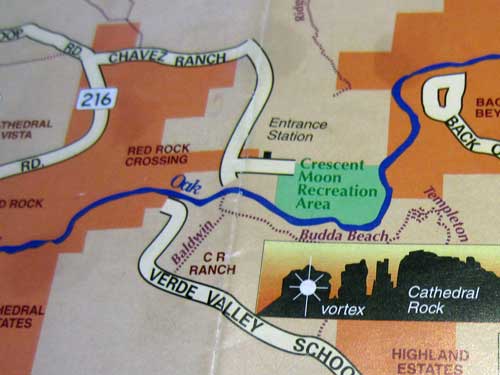

A beautiful drive

Sorry folks, park's closed.

Heading back
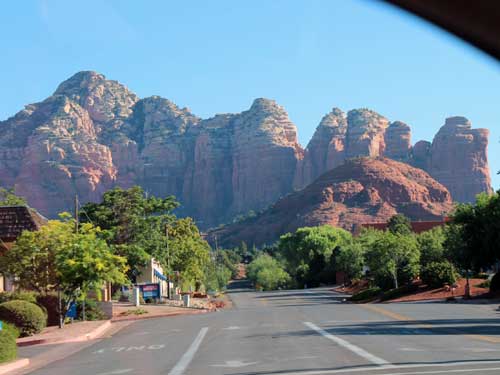
In town
Not to be thwarted so easily, we tried the vortex on Airport Road. We headed up a hill and pulled into a busy parking lot alongside the road. But the trail map didn't have the vortex marked, and since I didn't think I could find it just by "feeling it," we decided to move on. At least we got some lovely views of the city below.

It looked so easy...

... until we got there.

A stunning view of Sedona
It was about a two hour drive up to the Grand Canyon. It could have been shorter but we decided to go the scenic back way through Cameron.

On the road again
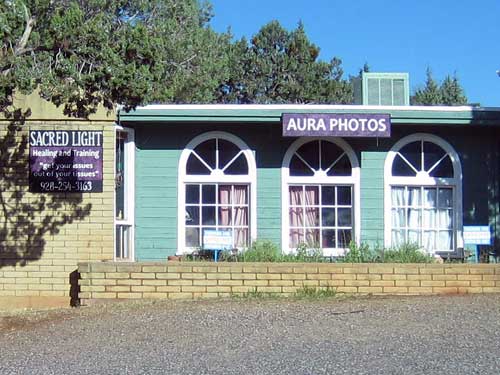
A typical business in spiritual Sedona

Highway 179 had more traffic circles than actual road!...

... but eventually it got much better as we left town.





Highway 17 back up to Flagstaff

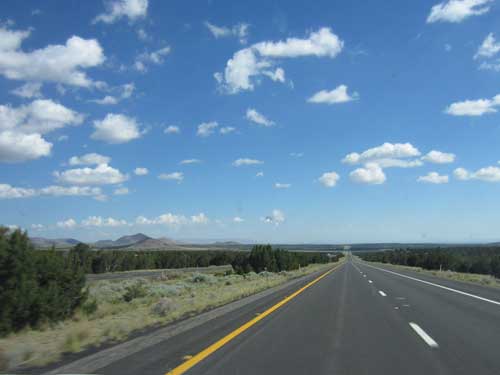
Then Highway 89 to Cameron

With a population of under 1,000, there wasn't a whole heck of a lot in Cameron... but it did have these huge, new roads!

Highway 64 led us past some scenic views and the incredible canyon carved by the Little Colorado River.


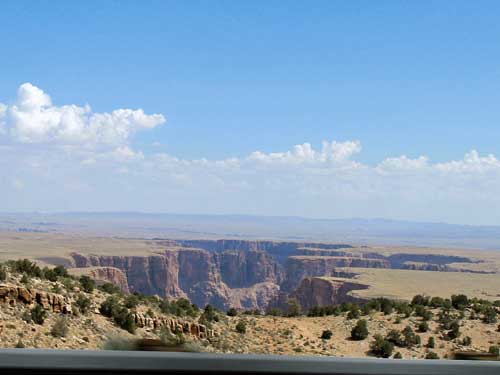
The Little Colorado River Canyon

The Little Colorado River is a tributary of the Colorado River, providing the principal drainage from the Painted Desert region. The Puerco River also flows into it. Although it stretches almost 340 miles, the lower 40 miles of which form one of the largest arms of the Grand Canyon, at over 3,000 feet deep.


Many booths selling native arts and crafts lined the road.

Almost there!


Entering the park
Given how famous the Grand Canyon is worldwide, one would think it would be one of the first national parks created. Actually it's 15th. The first bill to establish Grand Canyon National Park was introduced in 1882 by Senator Benjamin Harrison. It failed. Harrison tried again in 1883 and 1886, but still no luck. After he became president, he established the Grand Canyon Forest Reserve in 1893. It then became a Game Preserve in 1906 and a National Monument in 1908. It was defeated in both 1910 and 1911, but eventually became a National Park under President Woodrow Wilson in 1919.
Our top five oldest national parks:
Yellowstone in 1872
Sequoia in 1890
Yosemite in 1890
Mount Ranier in 1899
and Crater Lake in 1902

Benjamin Harrison (1833 - 1901), 23rd President of the United States from 1889 to 1893
The Grand Canyon is 277 miles long, up to 18 miles wide and reaches a depth of 6,093 feet (over one mile). It took the Colorado River about 5 to 6 million years to carve it, exposing nearly two billion years of Earth's geological history. The area is comprised of several national parks, national monuments, national forests, national reservation areas, the Hualapai Tribal Nation and the Navajo Nation.

We were only going to see this tiny corner of it.
We made several stops along the scenic 25-mile long Desert View Drive on our way from the Desert View Watchtower to the Visitor Center.

Driving along the southeastern rim of the canyon
People have lived in this for at least 12,000 years. A broken spear point tells of ancient hunters tracking giant sloths… a 4,000-year old twig figurine in a remote cave hints at early beliefs... Ancestral Puebloan villages came and went… as did Spanish explores, priests, trappers, prospectors and tourists.
The first tourist accommodation on the South Rim was built in the late 1890's. To get there, one had to take a bumpy all-day stagecoach ride from Flagstaff which cost about $20 (equivalent to around $500 today). In 1901, the train arrived, providing just a 3-hour trip for only $3.95.
Fred Harvey (along with his Harvey girls) was there to accommodate travelers. In 1915, he began offering car tours along the rim as well. To provide more services for his tourists, he developed Desert View in the 1927 with the help of his architect Mary Elizabeth Jane Colter (about whom we learned in the Petrified Forest) and the Civilian Conservation Corp.
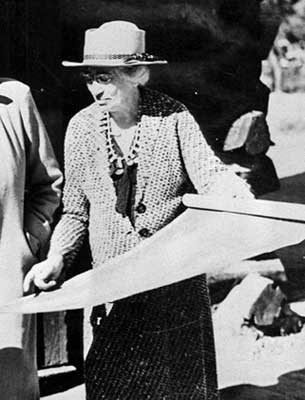
Mary Elizabeth Jane Colter reviews some plans.
The Watchtower was designed in 1932. It was a melding of various historic towers in the southwest.. "not an exact reproduction of any known ruin but, rather, is based on fine examples of the prehistoric workman, and is built in the Indian spirit."
Employed by the Fred Harvey Company to build this viewpoint and rest area, Colter used his railway engineers and bridge builders to erect a steel framework upon which the masonry walls would stand. She wanted it to blend in and look as if it belonged here, complete with intentionally designed flaws and cracks.

The tower's skeleton...

... and the finished product.
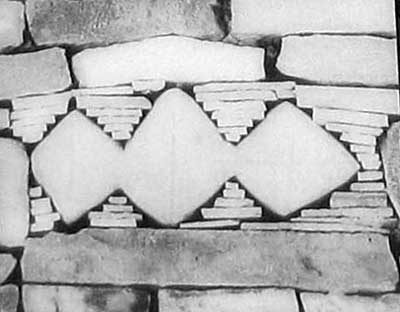
Diamond patterned rocks from Chaco Culture National Historic Park
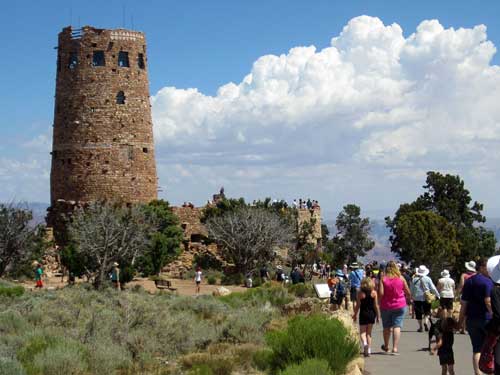
The Watchtower reaches 70 feet into the air.
Perched on the canyon rim, we got our first breathtaking views of the incredible gorge!



The Colorado River snakes its way far, far below.

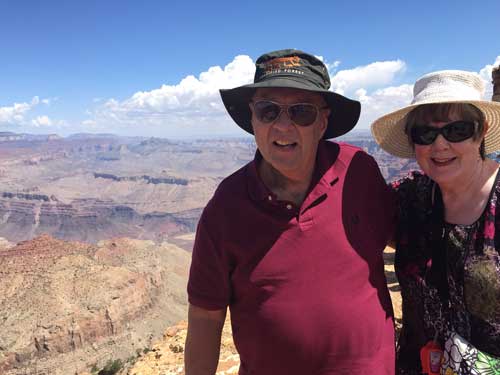
We made it!!
return • continue

